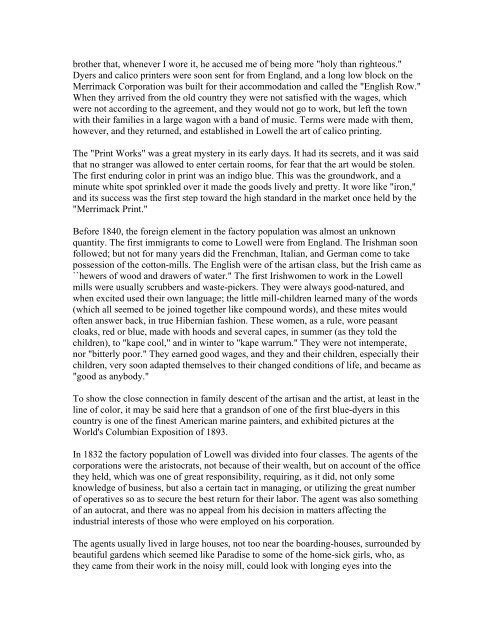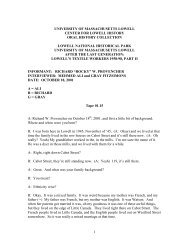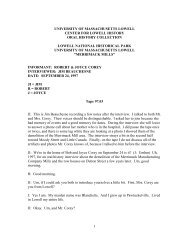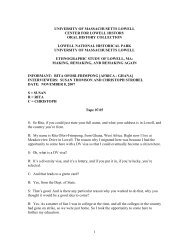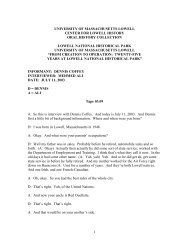LOOM AND SPINDLE OR Life Among the Early Mill Girls WITH A ...
LOOM AND SPINDLE OR Life Among the Early Mill Girls WITH A ...
LOOM AND SPINDLE OR Life Among the Early Mill Girls WITH A ...
Create successful ePaper yourself
Turn your PDF publications into a flip-book with our unique Google optimized e-Paper software.
o<strong>the</strong>r that, whenever I wore it, he accused me of being more "holy than righteous."<br />
Dyers and calico printers were soon sent for from England, and a long low block on <strong>the</strong><br />
Merrimack Corporation was built for <strong>the</strong>ir accommodation and called <strong>the</strong> "English Row."<br />
When <strong>the</strong>y arrived from <strong>the</strong> old country <strong>the</strong>y were not satisfied with <strong>the</strong> wages, which<br />
were not according to <strong>the</strong> agreement, and <strong>the</strong>y would not go to work, but left <strong>the</strong> town<br />
with <strong>the</strong>ir families in a large wagon with a band of music. Terms were made with <strong>the</strong>m,<br />
however, and <strong>the</strong>y returned, and established in Lowell <strong>the</strong> art of calico printing.<br />
The "Print Works" was a great mystery in its early days. It had its secrets, and it was said<br />
that no stranger was allowed to enter certain rooms, for fear that <strong>the</strong> art would be stolen.<br />
The first enduring color in print was an indigo blue. This was <strong>the</strong> groundwork, and a<br />
minute white spot sprinkled over it made <strong>the</strong> goods lively and pretty. It wore like "iron,"<br />
and its success was <strong>the</strong> first step toward <strong>the</strong> high standard in <strong>the</strong> market once held by <strong>the</strong><br />
"Merrimack Print."<br />
Before 1840, <strong>the</strong> foreign element in <strong>the</strong> factory population was almost an unknown<br />
quantity. The first immigrants to come to Lowell were from England. The Irishman soon<br />
followed; but not for many years did <strong>the</strong> Frenchman, Italian, and German come to take<br />
possession of <strong>the</strong> cotton-mills. The English were of <strong>the</strong> artisan class, but <strong>the</strong> Irish came as<br />
``hewers of wood and drawers of water." The first Irishwomen to work in <strong>the</strong> Lowell<br />
mills were usually scrubbers and waste-pickers. They were always good-natured, and<br />
when excited used <strong>the</strong>ir own language; <strong>the</strong> little mill-children learned many of <strong>the</strong> words<br />
(which all seemed to be joined toge<strong>the</strong>r like compound words), and <strong>the</strong>se mites would<br />
often answer back, in true Hibernian fashion. These women, as a rule, wore peasant<br />
cloaks, red or blue, made with hoods and several capes, in summer (as <strong>the</strong>y told <strong>the</strong><br />
children), to "kape cool," and in winter to "kape warrum." They were not intemperate,<br />
nor "bitterly poor." They earned good wages, and <strong>the</strong>y and <strong>the</strong>ir children, especially <strong>the</strong>ir<br />
children, very soon adapted <strong>the</strong>mselves to <strong>the</strong>ir changed conditions of life, and became as<br />
"good as anybody."<br />
To show <strong>the</strong> close connection in family descent of <strong>the</strong> artisan and <strong>the</strong> artist, at least in <strong>the</strong><br />
line of color, it may be said here that a grandson of one of <strong>the</strong> first blue-dyers in this<br />
country is one of <strong>the</strong> finest American marine painters, and exhibited pictures at <strong>the</strong><br />
World's Columbian Exposition of 1893.<br />
In 1832 <strong>the</strong> factory population of Lowell was divided into four classes. The agents of <strong>the</strong><br />
corporations were <strong>the</strong> aristocrats, not because of <strong>the</strong>ir wealth, but on account of <strong>the</strong> office<br />
<strong>the</strong>y held, which was one of great responsibility, requiring, as it did, not only some<br />
knowledge of business, but also a certain tact in managing, or utilizing <strong>the</strong> great number<br />
of operatives so as to secure <strong>the</strong> best return for <strong>the</strong>ir labor. The agent was also something<br />
of an autocrat, and <strong>the</strong>re was no appeal from his decision in matters affecting <strong>the</strong><br />
industrial interests of those who were employed on his corporation.<br />
The agents usually lived in large houses, not too near <strong>the</strong> boarding-houses, surrounded by<br />
beautiful gardens which seemed like Paradise to some of <strong>the</strong> home-sick girls, who, as<br />
<strong>the</strong>y came from <strong>the</strong>ir work in <strong>the</strong> noisy mill, could look with longing eyes into <strong>the</strong>


